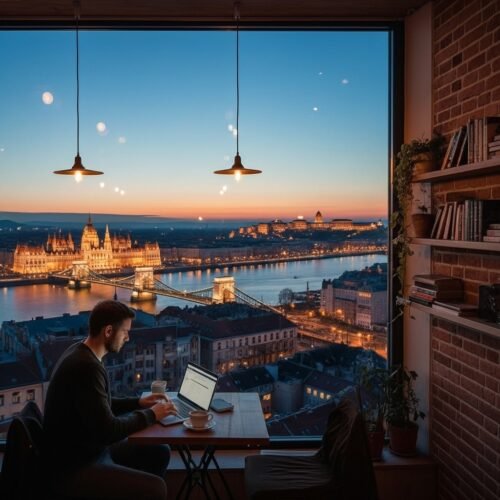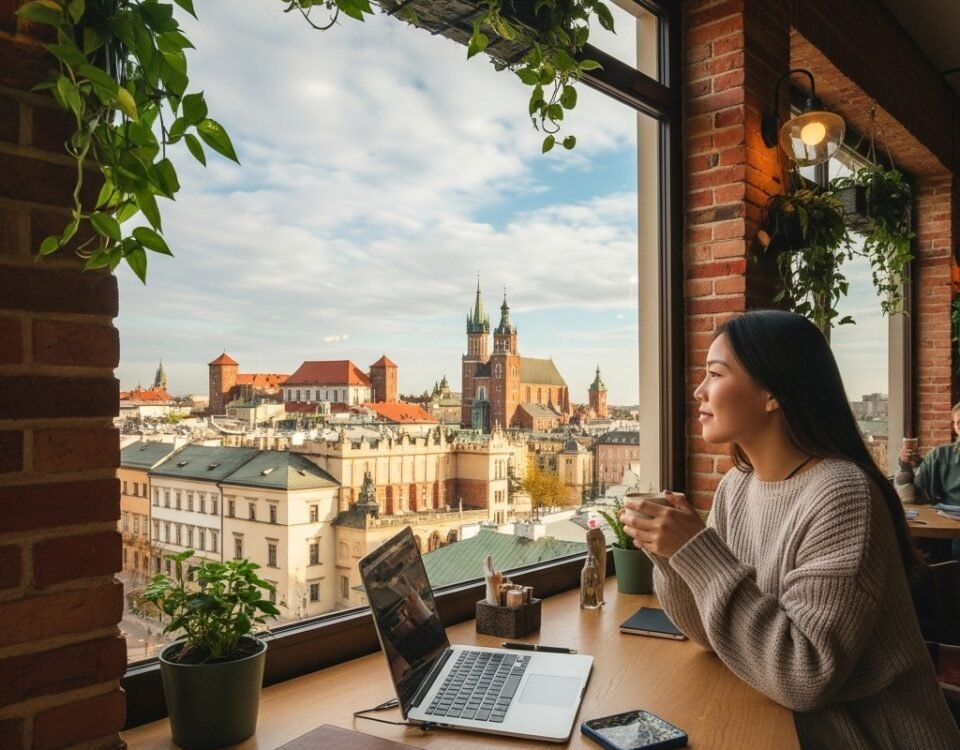Budapest is a city of stunning contradictions. Grand, imperial boulevards give way to gritty, beautifully decaying ruin bars. Centuries-old thermal baths offer healing waters just a stone's throw from bustling modern cafes. It's a city with a deep soul and an undeniable energy. This guide is your key to unlocking one of Central Europe's most captivating and affordable hubs for digital nomads.
Best Time to Visit:
Spring (Apr-Jun) and Autumn (Sep-Oct)
Average Cost:
€1,100 - €1,700 / month
Wi-Fi Speed:
Generally fast and reliable in the city center.
Visa Situation:
Schengen Zone
Pros
Stunning architecture, extremely affordable, world-famous nightlife (ruin bars), rich history, and relaxing thermal baths.
Cons:
Winters can be very cold and grey, the Hungarian language is challenging, and some areas outside the main districts can feel less polished.
Table of contents
- Why Budapest? My Personal Take
- Best Neighborhoods for Nomads & Backpackers
- Cost of Living: A Sample Budget in Budapest
- Co-working Spaces & Best Cafes with Wi-Fi
- Getting Around Budapest
- Top Things to See & Do (On a Budget)
- Visas, SIM Cards & Other Annoying Logistics
- The Verdict: Is Budapest Worth It for You?
- What's Your Favorite Spot in Budapest?
Why Budapest? My Personal Take
The magic of Budapest lies in its atmosphere. It's not as pristine as Vienna or as picture-perfect as Prague, and that's precisely its strength. There's an authenticity here, a creative energy born from repurposing the old into something new and exciting. The experience of finishing a productive workday and then soaking in the healing waters of a 100-year-old thermal bath, or exploring the quirky, art-filled maze of a ruin bar, is something you simply can't find anywhere else.
Best Neighborhoods for Nomads & Backpackers
District VII (Erzsébetváros - The Jewish Quarter)
The Vibe: The undisputed heart of the action. This is the home of the ruin bars, incredible street food, and a constant, energetic buzz. It’s vibrant, edgy, creative, and can be loud at night.
Best For: Social nomads, nightlife lovers, and those who want to be in the middle of everything.
District V (Belváros-Lipótváros - The City Center)
The Vibe: Grand, elegant, and central. Home to iconic landmarks like the Parliament and St. Stephen's Basilica. It’s more polished, generally more expensive, but offers incredible access to the entire city.
Best For: First-timers and those who prefer a more refined, central location.
District VI (Terézváros)
The Vibe: Known for the grand Andrássy Avenue, often called Budapest's Champs-Élysées. It's a mix of high-end shopping, theaters, embassies, and more residential streets. It feels a bit more grown-up than the party-centric District VII.
Best For: A good balance of culture, centrality, and residential calm.
Cost of Living: A Sample Budget in Budapest
| Category | Average |
|---|---|
| Accommodation (Private Room/Studio) | 550€ - 900€ |
| Groceries | 250€ |
| Eating Out & Coffee | 250€ |
| Public Transport (T-casual card) | 25€ |
| Co-working (Hot Desk) | 130€ |
| Activities & Fun | 150€ |
| SAMPLE TOTAL | 1,335€ - 1,705€ |
Co-working Spaces & Best Cafes with Wi-Fi
Budapest has a mature remote work scene with plenty of options.
KUBIK Coworking: A large, popular, and professional co-working space with a diverse community and multiple locations.
Loffice: One of the original co-working spaces in Budapest, known for its artistic and industrial-chic design.
My Little Melbourne: An excellent specialty coffee shop that is very welcoming to laptop workers.
New York Café: You probably won't get much work done here, but visiting the "Most Beautiful Café in the World" is an experience you have to have at least once.
Getting Around Budapest
Top Things to See & Do (On a Budget)
Soak in a Thermal Bath: A quintessential Budapest experience. Szechenyi is the largest and most famous; Gellért is known for its stunning Art Nouveau architecture.
Explore the Ruin Bars: Start with Szimpla Kert, the legendary spot that started it all. It's a sprawling, eclectic maze of art, music, and cheap drinks.
Walk the Buda Side: Cross the iconic Chain Bridge, hike up to Buda Castle, and take in the panoramic views from Fisherman's Bastion.
Eat Like a Local: You must try a hearty bowl of Goulash and a piece of Lángos (deep-fried dough with sour cream and cheese) from the Great Market Hall.
Visas, SIM Cards & Other Annoying Logistics
Visas: Hungary is in the Schengen Zone (90/180 day rule).
Hungary's Digital Nomad Visa: Officially called the "White Card," this visa allows remote workers to reside in the country for up to one year, with the possibility of renewal.
Currency: Crucial tip! Hungary uses the Hungarian Forint (HUF), not the Euro. Using a card like Wise or Revolut is the best way to avoid poor exchange rates and fees.
SIM Cards: Readily available from providers like Vodafone, Yettel, and Magyar Telekom.
Language: Hungarian is famously one of the most difficult languages to learn. Thankfully, English is widely spoken in the city center, but learning basics like Szia (Hello) and Köszönöm (Thank you) will earn you smiles.



